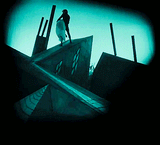Search Results
8/7/2025, 11:30:18 AM
>For much of the twentieth century a fixture in critics’ lists of the most significant films ever made, The Cabinet of Dr. Caligari (Das Cabinet des Dr. Caligari, 1920)' is often described as the founding film of “art cinema,” imbuing a form of cultural production—the popular cinema—with both the critical currency and the narrational uncertainties ofmodernism. In Caligari, a tale of horror and detection becomes in the end an object lesson in the untrustworthiness of narration. As embodied in the film, art cinema was able to ensure its success in Germany by launching an imaginative publicity campaign that lured prospective spectators with the enigmatic slogan “You must become Caligari!”—a campaign that lent an extrafilmic, mass-audience dimension to a line drawn from the film. At the same time, Caligari’s international success came as the result of product differentiation strategies that intended to establish German cinema’s distinctiveness from other national cinemas, particularly the increasingly dominant American one(Elsaesser, “Film History” 71-73; Kracauer 65).
>... the most durable legacy of Expressionism is its tracking of an isolated male character whose delusions, in the absence of any countervailing account of events, become welded to the impression of reality. That protagonist’s projections are signaled as such only by their excessiveness, which furnishes an excuse for stylistic violence and eccentricity. The striking style becomes commodified, though, as a way of attracting attention: no longer a sign of the damage an older generation has inflicted on the mind of the young, Expressionist protagonist, this style becomes the spectacular announcement of the arrival of a new gun in town.
>... the most durable legacy of Expressionism is its tracking of an isolated male character whose delusions, in the absence of any countervailing account of events, become welded to the impression of reality. That protagonist’s projections are signaled as such only by their excessiveness, which furnishes an excuse for stylistic violence and eccentricity. The striking style becomes commodified, though, as a way of attracting attention: no longer a sign of the damage an older generation has inflicted on the mind of the young, Expressionist protagonist, this style becomes the spectacular announcement of the arrival of a new gun in town.
Page 1
